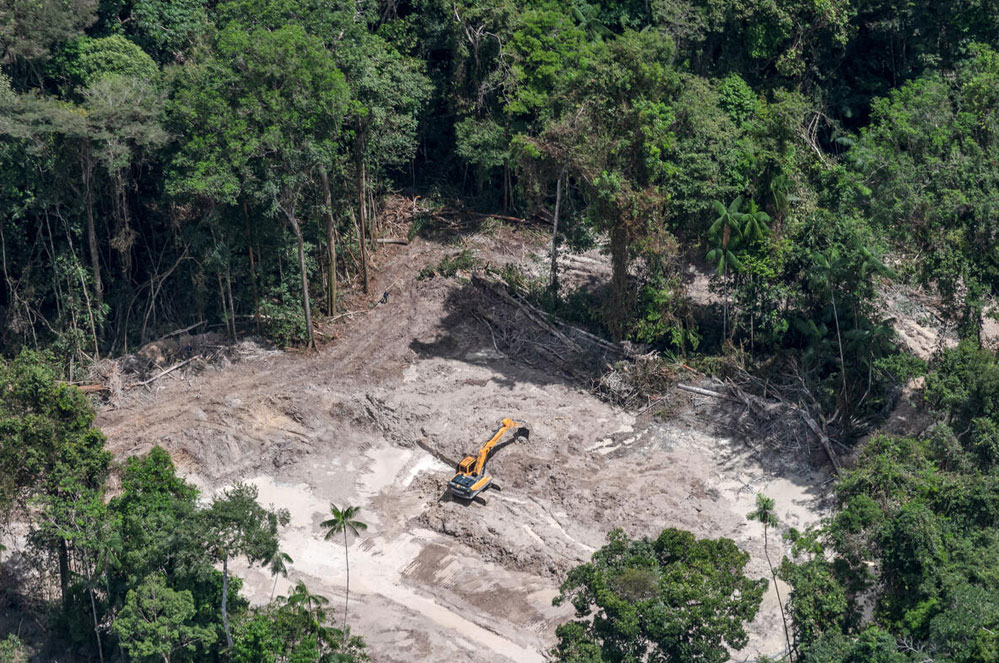Greenpeace Brazilië deed vorige maand onderzoek vanuit de lucht in het Amazonegebied en ontdekte illegale mijnbouw op land van het inheemse volk de Munduruku (in de staat Pará) en in andere beschermde gebieden. 72 procent alle mijnbouwactiviteiten tussen januari en april 2020 vond trouwens plaats in beschermd gebied, aldus het Braziliaanse Nationaal Instituut voor ruimteonderzoek (INPE).

“Terwijl de wereld kampt met de covid-19-pandemie, krijgen de inheemse volkeren in Brazilië met een andere plaag af te rekenen: mijnbouw. Onze luchtfoto’s tonen duidelijk dat de mijnbouw het regenwoud zwaar teistert, terwijl het Amazonewoud en al wie er woont net beschermd moeten worden”, reageert Sebastien Snoeck, die de ontwikkelingen in het Amazonewoud volgt voor Greenpeace België.
Meer info in het persbericht hieronder:
Massive increase of mining in Brazilian conservation areas and Indigenous lands during the COVID-19 pandemic
São Paulo, June 25, 2020 – Greenpeace research overflights carried out last month detected dramatically increased illegal mining in conservation areas, like national parks but also on Indigenous lands, such as the Northeast of the territory of the Munduruku Indigenous People, located in the Brazilian State of Pará. This is especially worrisome in light of the novel coronavirus being transmitted to those areas by miners and illegal loggers. According to DETER-alerts from the Brazilian Institute for Space Research (INPE), 72% of all mining conducted in the Amazon between January and April 2020 occurred within “protected” areas, such as conservation units and on Indigenous lands. Greenpeace denounced these illegal activities to the local authorities and called on the Brazilian government to take its duty and make sure there are no invasions on protected lands.
Carolina Marçal, forest campaigner at Greenpeace Brazil, said: “While the world is fighting the COVID-19 pandemic, Indigenous People in Brazil face a second epidemic, called mining. Our aerial images clearly show that mining is a plague of destruction of the rainforest, that by law, should protect forest and people living in the Amazon.”
In the first four months of 2020, deforestation for mining increased with 13.44% within Indigenous Lands in the Brazilian Amazon compared to the same period last year (383.3 hectares in 2019 to 434.9 hectares in 2020). Mining destroyed 879.8 hectares of forest in conservation areas between January and April this year, which represents an increase of 80.62% when compared to the same period of 2019 when 487.12 hectares were deforested.
| Greenpeace overflights showed area deforested for mining from January to April 2019/2020 | ||
| Protected land | Hectares 2019 | Hectares 2020 |
| Munduruku | 152.8584 | 241.3174 |
| Sai Cinza | 0 | 21.75703 |
| Altamira National Forest | 0 | 13.3575 |
| Jamanxim National Park | 0 | 23.43102 |
Greenpeace Brazil is regularly conducting research flights to detect and analyse deforestation and forest destruction. In the northeast of the TI Munduruku Greenpeace found a mine recently opened within the borders of the Sai Cinza Indigenous land. Tractors, hydraulic backhoes, and even roads were detected in the two traditional territories of the Munduruku Indigenous People, located in the Jacareacanga region in Brazil. The Munduruku and Sai Cinza Indigenous lands alone account for 60% of the deforestation alerts for mining on Indigenous lands in the Amazon, and identified by INPE data from January to April 2020. During one overflight, it was also possible to film the mining exploitation within two Conservation Units located in the state of Pará: the Altamira National Forest and the Jamanxim National Park. The latter is a fully protected conservation area, where mineral exploration is prohibited by law. [1]
The current Brazilian administration has set measures and attempts to weaken the environmental legislation. Even during the greatest pandemic in contemporary history, regulations such as the PL 191/2020, which intends to open indigenous lands for the exploitation of mineral and water resources or the PL 26633/2020, which promises to legalize illegally-grabbed public lands until December 2018 were implemented to wash out environmental protection and Indigenous rights. In addition to the pressure by invasions of land grabbers, loggers, and miners, Indigenous Peoples face Funai’s willingness to subvert their duty to promote and protect the rights of Indigenous Peoples since Normative Instruction 09/2020, published by FUNAI, prefers to recognize the land interests of non-indigenous people and to turn their back on the recognition of Indigenous lands, which puts hundreds of territories at risk while awaiting the final phase of a long demarcation process.
“COVID-19 is spreading fast into the Amazon rainforest and to the Indigenous communities. It becomes more than urgent that the Brazilian federal government responds to the alerts issued by Indigenous leaders and INPE to avoid the extinction of entire Indigenous groups. Greenpeace together with its partners continue to monitor and report activities that endanger the health and lives of Indingeous People and their lands”, said Marçal.
Overflight images: https://media.greenpeace.org/collection/27MDHUN9KZG
Notes:
[1] According to Article 231 of Brazil’s Federal Constitution, any mining activity within Indigenous Lands is illegal. In conservation units, mining can only be developed in a few sustainable use categories, with the proper authorization, as provided by the Brazilian System of Protected Areas (SNUC) Law 9985/2000.
